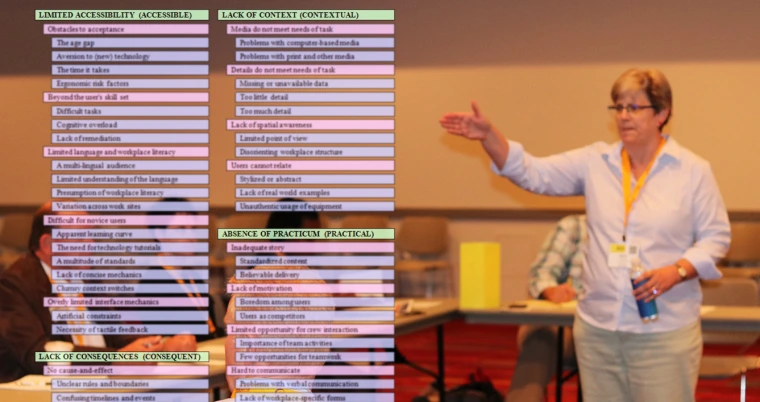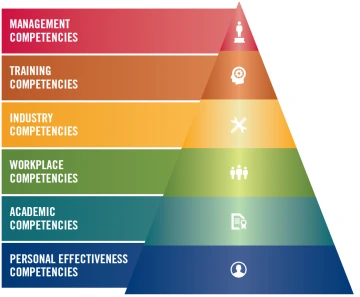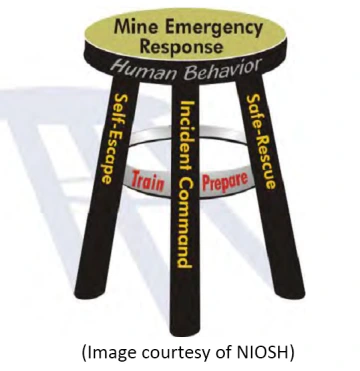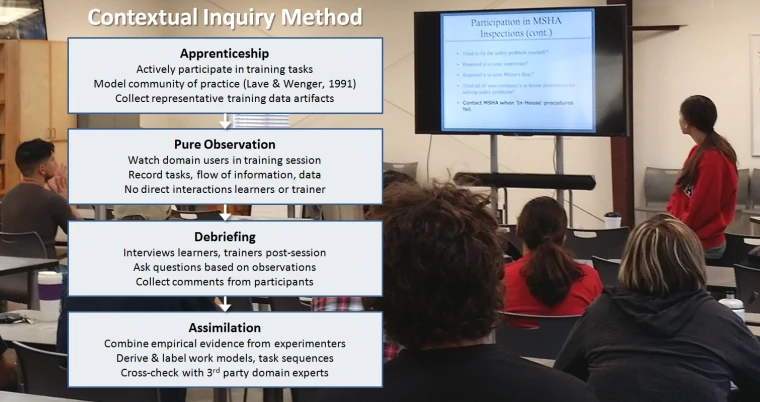
The Center has developed and validated several mining-specific competency models for training and assessment. To better capture the many aspects of competency, our models were developed through multi-disciplinary collaborations with researchers in mining, safety, education, information, law, and public health. Our competency models include the following:
- Mine Trainer Competency Model
- Emergency Preparedness & Response Competency Models
- Design Guidelines for Mine Safety Training
Mine Trainer Competency Model
The Mine Trainer Competency Model identifies six critical domains of Knowledge, Skills, Abilities, and Other attributes (KSAOs) for mining industry personnel involved in training. In developing this mining-specific competency model, the Center's researchers applied a Human Resource Development (HRD) approach[1] to answer three key questions:
- Who needs training?
- What type of training do they need?
- Does this type of training currently exist?
Our competency model provides a foundation to answer these questions from a data perspective rather than a compliance perspective. The model draws on existing frameworks in HRD, including the Competency Model of the Association for Talent Development[2] and the Foundational - Work Readiness Competencies developed by Employment and Training Administration.[3] Together these models accumulate over 30 years of best practices in professional development relating to training and allied occupations.

The Mine Trainer Competency Model provides a clear path for developing new training curricula and programs, evaluating existing curricula, creating certification programs, and evaluating performance. It is a vital resource to all mining personnel involved in learning and development — in particular, trainers (i.e. safety, technical, on-the-job, field trainers, and task trainers), training managers (i.e. supervisors, superintendents, and chief learning officers), and instructional designers (i.e. curriculum developers and training developers).
Quick Facts: Mine Trainer Competency Model
| Media Type | Competency Model |
| Principal Investigators | Michelle Lutz, Laurie Wilson, Mary Poulton |
| Target Audience | Trainers, Instructional Designers, HSE Managers, Executives |
| Competency Domains | Management, Training, Industry, Workplace, Academic, Personal Effectiveness |
| Primary Sectors | All Sectors |
| Train-the-Trainer? | Available |
| Downloads | Mine Trainer Competency Model: Overview (PDF), Mine Trainer Competency Model: Full Definition (PDF) |
Emergency Preparedness & Response
This two-part competency model considers both the preparedness and response aspects of mine emergencies. Each model contains six domains addressing the core features of a mine emergency response system, including organizational leadership, command and control, and the individual miner. The competency models are intended to assist in planning, curriculum development, and performance measurement. Note that the models focus on self-escape aspects of mine emergencies. They are intended for individual miners faced with adverse and hazardous conditions who can:
- Act as first responders to assist others in self-escape
- Mitigate limited hazardous conditions until help arrives

The Mine Emergency Preparedness and Response Competency Models were developed from established frameworks, including the CDC National Preparedness Goal Core Capabilities for Public Health Preparedness[4] and the FEMA Emergency Response Core Competency Model.[5] Our competency models have been validated with industry partners using a DELPHI process. They have also been piloted for supervisor training in our Incident Command, Escape & Rescue Workshop. Funding for this initiative was provided in part by the Mine Safety and Health Administration through the Brookwood-Sago Mine Safety Grants Program.
Quick Facts: Emergency Preparedness & Response Competency Models
| Media Type | Competency Models (2) |
| Principal Investigators | Brenda Granillo, Staci Martin |
| Target Audience | Trainers, Incident Commanders, Mine Rescue |
| Competency Domains | Leadership and Decision-Making, Communications and Crisis Management, Hazard Recognition and Avoidance, Regulatory Compliance, Worker Safety and Health, Miner Resiliency |
| Primary Sectors | Coal (Underground), Metal / Non-Metal (Underground) |
| Train-the-Trainer? | Available |
| Downloads | Emergency Preparedness Competency Model for Self-Escape (PDF), Emergency Response Competency Model for Self-Escape (PDF) |
Guidelines for Mine Safety Training
For more than a decade, researchers have called for fundamental changes in the way miners are trained and the materials used to train them.[6] Looking at the problem from a Human Factors perspective, the Center conducted a multi-year needs assessment, identifying 15 guidelines to improve training resource design and delivery for miner-specific safety and health.[7] The guidelines were derived using an approach called Contextual Inquiry[8] and verified with four cohorts of industry trainers.

Although not a competency model in the traditional sense, the Design Guidelines for Mine Safety Training address four key themes of usability problems found in existing training materials:[7]
- Limited Accessibility. Promote acceptance across a range of worker demographics, engaging a new generation of miners in addition to experienced miners. Accommodations should be made to address computer and workplace literacy issues as well as second language learners.
- Lack of Context. Provide a meaningful context and level of detail to illustrate important relationships. In particular, training must be grounded in the familiar, relating new concepts to each worker's experience.
- Lack of Consequences. Illustrate the consequences of choices. Workers require a better understanding of timelines and causality if they are to recognize hazards and anticipate the outcomes of good and bad choices.
- Absence of Practicum. Emphasize story-driven scenarios and evaluation. Hands-on activities reinforce learning and allow for the assessment of worker safety competencies.
The Design Guidelines for Mine Safety Training are useful to instructional designers, as they provide a set of validated "Rules to Live By" for developing new training materials, evaluating the effectiveness of existing resources, and comparing alternatives.
Quick Facts: Design Guidelines for Mine Safety Training
| Media Type | Competency Model (Design Guidelines) |
| Principal Investigators | Leonard Brown, Mary Poulton |
| Target Audience | Trainers, Instructional Designers |
| Usability Themes | Accessible, Contextual, Consequent, Practical |
| Primary Sectors | All Sectors |
| Train-the-Trainer? | Available |
| Downloads | Design Guidelines for Mine Safety Training (PDF) |
Further Reading
- Salas, E., Tannenbaum, S.I., Kraiger, K., & Smith-Jentsch, K.A. (2012). "The Science of Training and Development in Organizations: What Matters in Practice." Psychological Science in the Public Interest, 13(2), pp. 74-101. https://doi.org/10.1177/1529100612436661
- Association for Talent Development. (2013). American Society for Training and Development (ASTD) Competency Model. Available at Association for Talent Development
- Employment and Training Administration, Dept. of Labor (DOL), U.S. (2020). Foundational Competencies or Work Readiness Competencies. Available at DOL Competency Model Clearinghouse
- Centers for Disease Control and Prevention: Office of Public Heath Preparedness and Response & the Association of Schools of Public Health, U.S. (2012). Knowledge, Skills, and Attitudes (KSAs) for the Public Health Preparedness and Response Core Competency Model. Available at Assoc. of Schools and Programs of Public Health
- Federal Emergency Management Agency (FEMA), Dept. of Homeland Security, U.S. (2011). National Preparedness Goal Core Capabilities. Available at Federal Emergency Management Agency
- Peters, R.H., Vaught, C., & Mallet, L. (2010). "A Review of NIOSH & US Bureau of Mines Research to Improve Miner's Health & Safety Training," Extracting the Science: A Century of Mining Research, Brune, J. (Ed.), pp. 501-509, SME Society for Mining, Metallurgy & Exploration, Inc; Littleton CO. Available at National Institute for Occupational Safety and Health
- Brown, L. D. (2015). Design, Evaluation, and Extension of Serious Games for Training in Mine Safety. Ph.D. Dissertation, Dept. of Computer Science, Univ. of Arizona, Tucson, AZ. Available at Univ. of Arizona Libraries
- Beyer, H. & Holtzblatt, K. (1997). Contextual Design: Defining Customer-Centered Systems. Morgan Kaufmann, San Francisco. ISBN: 1558604111.

